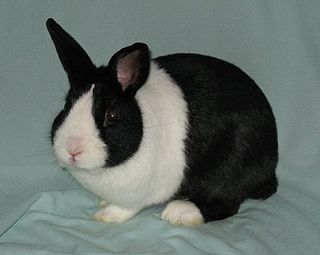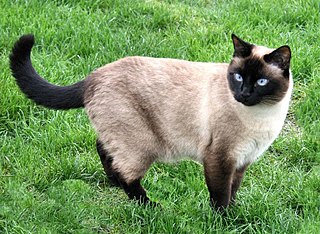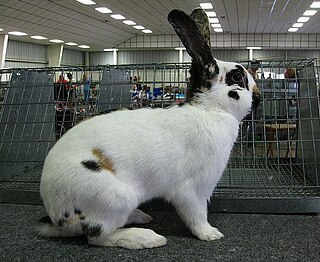
The Angora rabbit, one of the most ancient groups of domestic rabbit breeds, which is bred for the long fibers of its coat, known as Angora wool. They are gathered by shearing, combing or plucking. Because rabbits do not possess the same allergy-causing qualities as many other animals, their wool is an important alternative. There are at least 11 distinct breeds of Angora rabbit, four of which are currently recognized by the American Rabbit Breeders Association (ARBA): the English Angora, the French Angora, the Giant Angora and the Satin Angora. Other unrecognized breeds include the German Angora, the Finnish Angora, the Chinese Angora, the Japanese Angora, the Korean Angora, the Russian Angora, the St Lucian Angora and the Swiss Angora.

The Netherland Dwarf is a breed of domestic rabbit that originated in the Netherlands. Weighing 1.1–2.5 pounds (0.50–1.13 kg), the Netherland Dwarf is one of the smallest rabbit breeds. Its popularity as a pet or show rabbit may stem from its neotenic appearance. The Netherland Dwarf is recognised by both the American Rabbit Breeders Association (ARBA) and the British Rabbit Council (BRC). The Netherland Dwarf is often confused with the Polish breed of rabbit, but the latter has longer ears, a non-brachycephalic head and less cobbiness.

The Dutch rabbit, historically known as Hollander or Brabander, is a breed of domestic rabbit. It is easily identifiable by its characteristic color pattern and was once the most popular of all rabbit breeds. However, after dwarf rabbits were developed, the popularity of the Dutch rabbit declined. Nevertheless, the Dutch rabbit remains one of the top ten most popular breeds worldwide.

The Holland Lop is a breed of lop-eared rabbit that was recognized by the American Rabbit Breeders Association (ARBA) in 1979. The Holland Lop, with a maximum weight of 1.8 kg (4 lb), is one of the smallest lop-eared breeds.

Mini Rex is a breed of domestic rabbit that was created in 1984 in Florida by the late Monna Berryhill of Texas. The Rex mutation, derived in France in the 19th century, is recessive and causes the hair to protrude outwards from the body, instead of lying flat, and the guard hairs to be shortened to the length of the undercoat, or a bit longer.
The Beveren is one of the oldest and largest breeds of fur rabbits. It was first bred in Beveren, a small town near Antwerp in Belgium. Their coats can be blue, white, black and lilac, though not all of these varieties are ARBA-recognized. There is a rare variety called the Pointed Beveren, which comes in the same colors but has white tipped hairs. The blue variety is the original.

Acromelanism is a genetic condition that results in pigmentation being affected by temperature. It results in point coloration where the extremities of an animal are a different colour to the rest of the body. It is commonly known for the coloration of Siamese and related breeds of cat, but can be found in many other species including dogs, rabbits, rats, mice, guinea pigs, minks, and gerbils. It is a specific type of point coloration.

The Argenté rabbit is one of the oldest breeds of French show rabbits. The British Rabbit Council (BRC) recognises six varieties: Argenté Bleu, Argenté Brun, Argenté Crème, Argenté de Champagne, Argenté Noir, and Argenté St Hubert. The American Rabbit Breeders Association (ARBA) recognises the Champagne d'Argent, the Crème d'Argent and the Argenté Brun. A rare variety, the Argenté Clair, is not currently recognised by either the BRC or ARBA.
The English Lop is a fancy breed of domestic rabbit that was developed in England in the 19th century through selective breeding. It is believed to be the first breed of lop rabbit developed by humans, and it may be one of the oldest breeds of domestic rabbit. Averaging 5.5 kg (12 lb), the English Lop is characterised by its distinctively long lop ears, bold head, and large body size.
Plush Lop is a breed of domestic rabbit with two varieties: Miniature and Standard. There is also a Canadian Plush Lop breed in development. Similar in appearance, the Velveteen Lop breed is also in development. Miniature Plush Lops were the first to be developed. Devie D'anniballe began creating this breed in 1995 in the United States. She succeeded in developing them by combining the previously existing breeds of Holland Lop, Mini Rex, and Mini Lop. Her aim was to create the perfect pet by retaining the good qualities of these breeds, while "breeding out" all the problems existing in these breeds.
Colours of the Syrian hamster can be described in three ways: as "self", "agouti" or "combinations". Self colours are a consistent coat colour with the same colour topcoat and undercoat. Agouti hamsters have a ticked coat, where each individual fur is banded in different colours. Agouti hamsters also have "agouti markings" which consist of dark cheek markings, a dark marking on the head, and a light underbelly. Combinations are produced when two self or agouti colours are present.

Miniature Lop is a breed of domestic rabbit recognised by the British Rabbit Council (BRC). Confusion arises because, in the UK, the Miniature Lop is often commonly called the Mini Lop. It is, however, a different breed from the Mini Lop that is recognized by the American Rabbit Breeders Association (ARBA). The BRC-recognized Miniature Lop is most similar to the ARBA-recognized Holland Lop. The Miniature Lop is also similar to several other small rabbit breeds.

The Rhinelander is a medium-sized breed of domestic rabbit that originated in Germany. Rhinelanders are known for their distinctive facial "butterfly markings", a spine marking, colored ears, cheek spots, eye circles and side markings of black with orange or of blue with fawn. The Rhinelander breed is recognized by the British Rabbit Council (BRC) and by the American Rabbit Breeders Association (ARBA).

The Harlequin is a colourful breed of rabbit originating from France. It is a breed based around the coloration and markings, rather than fur and body type. The ideal weight of a standard Harlequin is 6.5-9.5 lb (2–3 kg), with bucks (males) weighing 6.5-9 lb, and does (females) weighing 7-9.5 lb.

The Himalayan rabbit is a small breed of rabbit with similar markings to the Californian rabbit. The body is white with colored points, recognized colors are black, blue, chocolate and lilac.

Dwarf Hotot is a breed of domestic rabbit characterized by an entirely white coat, except for a circle of another color around each eye.
The Velveteen Lop is a breed of lop-eared rabbit developed from Mini Rex and English Lop ancestry in the United States from the late 1980s through early 1990s. It is the first American rabbit breed to combine lopped ears and rex fur. Velveteens are known to have friendly, gentle personalities. They are medium-sized rabbits weighing 5 to 7 pounds when fully grown and come in a wide variety of coat colors.












